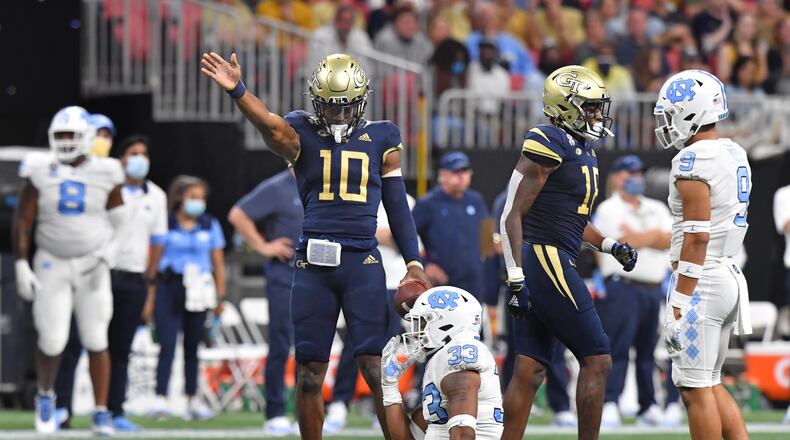On Saturday night at Mercedes-Benz Stadium, Georgia Tech collected 45 points and 261 rushing yards in its win over North Carolina. In Tar Heels coach Mack Brown’s second tenure, it was the most points given up in a loss and the most rushing yards allowed in any game.
To Tech offensive coordinator Dave Patenaude, though, it was not a time to gloss over mistakes.
“I think that’s the time that you have to be hypercritical,” Patenaude said Tuesday. “You have to be hypercritical with the staff, you’ve got to be hypercritical with the calls, the preparation, the execution, and then you’ve got to take that to the players in the meetings and say, ‘Listen, we did this well, we didn’t do this well. This is why we didn’t do it well.’ And so that’s what we did.”
Among the facets of his offense being placed under the harshest light is the play in the red zone. On both the third and fourth drives of the game, the Jackets not only were inside the UNC 20-yard line but had first-and-goal on the Tar Heels 10. On both possessions, the Jackets settled for field goals as missed blocks, penalties and other misplays kept them out of the end zone.
With Jeff Sims replacing Jordan Yates at quarterback, Tech got into the end zone on its next three red-zone possessions, but then came up short again in the fourth quarter, failing to punch it in after Jordan Mason’s 29-yard run set up first-and-goal from the 5.
It continued Tech’s red-zone shortcomings from the Clemson game, when the Jackets had first-and-goal at Clemson’s 10, 7 and 3 and managed only two field goals in the 14-8 loss. A pivotal moment in the season-opening loss to Northern Illinois was Tech’s inability to get into the end zone from a first-and-goal from the 5.
Because of the effectiveness of kicker Brent Cimaglia, who is 6-for-6 after missing his first two attempts in the season-opening loss to Northern Illinois, Tech has scored on 15 of 18 red-zone possessions, a rate (83.3%) that is tied for seventh in the ACC and stands as progress from last season’s rate of 66.7%, tied for 14th in the conference.
However, Tech has scored touchdowns on nine of the 18 possessions, a rate (50%) that ranks last in the ACC. Generally, teams in the top 20th percentile of FBS score touchdowns on at least 70% of their red-zone possessions.
“We’re very fortunate that our kicking game is really solid,” Patenaude said. “But from a coordinator standpoint, that’s not good enough.”
Patenaude said that he and the offensive staff examined the plays run in the red zone to understand the flaws. Were plays executed properly? Were they too predictable? Is a certain position getting the ball too much or not enough? What does the defense appear to be anticipating?
“That’s something that we have to work on,” he said.
The Jackets have tried different approaches in the red zone, such as speeding up the tempo between plays, which Collins said is “kind of our DNA” and has been “really effective for us.” In the final minute against Clemson, starting from first-and-goal from the 3 and needing a touchdown, Tech used two tight ends (Dylan Deveney and Billy Ward) with one back and two receivers, unsuccessfully trying two runs (including a jet sweep to wide receiver Kyric McGowan, technically a pass) and two passes, including a shovel pass to Deveney on fourth down.
In the fourth quarter against North Carolina on a third-and-goal from the 4, Tech tried an unusual grouping – six offensive linemen (offensive tackle Kenneth Kirby lined up to the left of left tackle Devin Cochran), two backs (Jamious Griffin and Dontae Smith) and two receivers (PeJe Harris and Adonicas Sanders) – for a jet sweep to Smith. It was not blocked well, and Smith lost four yards. Cimaglia kicked a 31-yard field goal.
On Tuesday, Collins hinted at some new packages to get defensive players onto the field.
At Temple, “we had some good things that we did there getting bigger bodies onto the field,” Collins said. “And even if you have to use some defensive players, you do that.”
In his two seasons with the Owls, Collins used a 330-pound defensive tackle at fullback (Freddie Booth-Lloyd), three times giving him the ball for one-yard touchdown runs in 2018. The idea of defensive tackle Zeek Biggers (listed at 6-foot-6, 363 pounds) lining up at fullback – a role he filled in high school, even scoring once – is intriguing.
Whatever the answer is, it would behoove the Jackets to find solutions. Getting the offense to line up before the play clock expires has been another challenge, as the Jackets burned timeouts against Northern Illinois, Clemson and North Carolina in goal-to-go downs with the play clock running down.
Given his size, strength, explosiveness and ball skills, wide receiver Malachi Carter would seem an underutilized target close to the goal line.
The offense merits credit for getting the ball into the red zone, and even inside the 10-yard line. But the pattern of settling for field goals has cost Tech points that it already hasn’t had the margin to afford.
Pittsburgh will bring the No. 2 scoring offense in FBS at 52.5 points per game (playing FCS New Hampshire, Massachusetts and Western Michigan tilts the numbers, although the Panthers also put up 41 points on Tennessee). Should the Jackets find themselves in a shootout, they likely won’t win it with a flurry of 25-yard field goals.
“We want the kicker to go out there and kick PAT’s, not field goals,” Patenaude said.
About the Author
Keep Reading
The Latest
Featured


